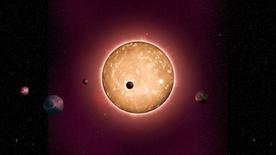
Scientists have located an ancient solar system, dating back to the dawn of the galaxy, which appears to be a miniature version of the inner planets in our own solar system.
An international research group, including Yale University professors of astronomy Sarbani Basu and Debra Fischer, announced the discovery Jan. 27 in The Astrophysical Journal. The findings are the result of observations made by the NASA Kepler spacecraft over a period of four years.
The old, Sun-like star, named Kepler-444, has five orbiting planets with sizes between those of Mercury and Venus. Kepler-444 formed 11.2 billion years ago, when the universe was less than 20% of its current age. This makes Kepler-444 the oldest known system of terrestrial-sized planets. The Kepler-444 system was already older than our own solar system is today when our Sun and planets were born.
“This system shows that planet formation could take place under very different conditions from the ones in which our solar system was formed and has implications for estimating the total number of planets in our galaxy, and other galaxies,” Basu said.
The five planets in the Kepler-444 system have orbits that are equivalent to less than one-tenth of Earth’s distance from the Sun. The Kepler-444 planets are rocky and Earth-like, but their exact compositions are uncertain.
The scientists carried out their research using asteroseismology — listening to the host star’s natural resonances, which are caused by sound trapped within it. These oscillations lead to miniscule changes or pulses in the star’s brightness, allowing researchers to measure the star’s diameter, mass, and age. The planets were then detected from the dimming that occurs when the planets transited, or passed across, the stellar disc. This fractional fading in the intensity of starlight enabled scientists to measure accurately the sizes of the planets relative to the size of the star.
“There are far-reaching implications for this discovery,” said lead author Tiago Campante of the University of Birmingham (U.K.). “We now know that Earth-sized planets have formed throughout most of the universe’s 13.8-billion-year history, which could provide scope for the existence of ancient life in the galaxy.”
The research collaboration involved nearly two-dozen institutions in the United States, England, Denmark, Portugal, Australia, Germany, and Italy.
View an animation of Kepler-444 and its five orbiting planets here.
- YaleNews press release by Jim Shelton